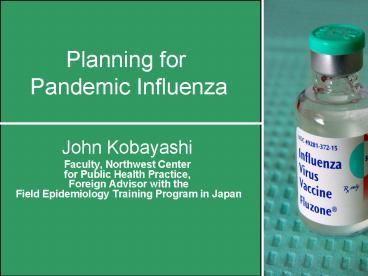Planning for Pandemic Influenza - PowerPoint PPT Presentation
1 / 14
Title:
Planning for Pandemic Influenza
Description:
The occurrence of more cases of disease than expected in a given ... Influenza as a Zoonosis. A Potential Source of 'Antigenic Shift' Human. virus. Reassortant ... – PowerPoint PPT presentation
Number of Views:32
Avg rating:3.0/5.0
Title: Planning for Pandemic Influenza
1
Planning for Pandemic Influenza
- John Kobayashi
- Faculty, Northwest Center for Public Health
Practice, Foreign Advisor with the Field
Epidemiology Training Program in Japan
2
Pandemic Influenza as aParadigm Emerging Pathogen
- Normal influenza season
- about 36,000 deaths in US
- Pandemic influenza
- 1918 -- 20,000,000 deaths worldwide
- -- 500,000 US deaths
- 1957 and 1968 pandemics -- 104,000 US
deaths
3
What is an Epidemic?
- The occurrence of more cases of disease than
expected in a given area or among a specific
group of people over a particular period of
time.
Epidemic
Reference Principles of Epidemiology, Richard
Dicker, CDC
4
What is a Pandemic?
- An epidemic occurring over a very wide area
(several countries or continents) and usually
affecting a large proportion of the population. - Examples
- Cholera
- AIDS
- Pandemic Influenza
Pandemic
5
What is Pandemic Influenza?
- Pandemic Influenza circulation of strains for
which most or all of the worlds population
lacks immunity. - Antigenic Drift small changes in influenza
viruses with partial immunity in the population
occurs routinely
- Antigenic Shift large changes with little
immunity in the population necessary for
pandemic influenza
6
Influenza virus structureHA hemagglutinin NA
- neuraminidase
NA-neuraminidase
HA-hemagglutinin
Image source CDC
7
Influenza Types and Strains
- Types A and B commonly infect humans
- Current vaccine
- H3N2 A/Fujian/411/2002
- H1N1 A/New Caledonia/20/99
- B/Shanghai/361/2002
8
Influenza as a ZoonosisA Potential Source of
Antigenic Shift
15 HAs 9 NAs
Non-human virus
Human virus
Reassortant virus
Diagram source Ben Schwartz National Vaccine
Program
9
WHO Influenza Pandemic PhasesInterpandemic Phase
0 (Emergence)
- Level 0 Usual influenza viruses circulate,
causing yearly outbreaks - Level 1 Novel Virus Alert -- Identification of
a novel influenza virus in a person - Level 2 Confirmation that the novel influenza
virus has infected two or more people, but rapid
person-to-person spread and multiple outbreaks
have not occurred. - Level 3 Pandemic Alert Confirmation of
person-to-person spread in the general population
with at least one outbreak lasting more than 2
weeks in one country
10
WHO Influenza Pandemic Phases
- Phase 1 The novel influenza virus is causing
several outbreaks in one country, and has spread
to other countries - Phase 2 Epidemics occurring in multiple
countries and spreading worldwide - Phase 3 End of the first pandemic wave
- Phase 4 Second or later waves
- Phase 5 End of pandemic
11
Problems with Pandemic Preparedness Surveillance
- Seeing only the tip of the iceberg (not all
cases seek medical care, not all physicians
obtain laboratory specimens, etc)
- Syndromic surveillance for respiratory diseases
is difficult - Lack of transparency in international reporting
- Conflicting interests in ministries of health,
agriculture and commerce.
12
Problems with Pandemic PreparednessVaccine
Development and Production
- Vaccine virus must be made in eggs
- Need adequate supply of eggs
- The pandemic strain may need to be genetically
modified so it doesnt kill eggs - There are few economic incentives for drug
companies to make vaccines - Who will assume liability for a national
vaccination program?
13
Problems with Pandemic PreparednessVaccine
Distribution and Administration
- In the first pandemic wave, there will probably
not be enough vaccine for all who want it - There may be little advance notice for these
priorities and they may change over time
- It will be necessary to prioritize who will
receive vaccine
14
Summary
- Pandemic influenza is very likely to occur at
some time in the future, but when? - Progress has been made at every level of public
health response (pandemic planning, surveillance,
vaccine development, distribution and
administration). - However, problems remain at every level.
- What can and is being done at the state, local
and tribal level to plan a pandemic response?































